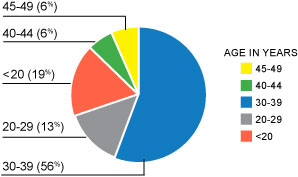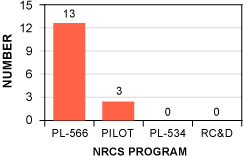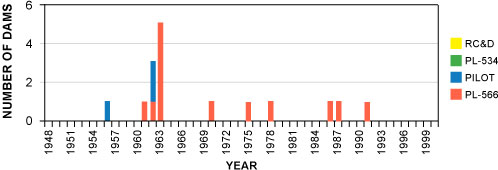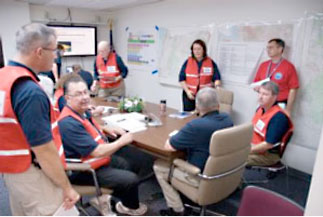About EAPs
An EAP is Thorough, Updated and Tested
An Emergency Action Plan (EAP) is a formal document that identifies potential emergency conditions at a dam and specifies preplanned actions to be followed to minimize property damage and loss of life should those conditions occur. The EAP contains procedures and information to assist the dam owner in issuing early warning and notification messages to responsible downstream emergency management authorities. It also should contain inundation maps to show the emergency management authorities the critical areas for action in case of an emergency.

The California Office of Emergency Services (CalOES) uses a state-specific template for dam owners and emergency managers to use in developing EAPs for HHP dams. In designing the template, EAP forms and formats from several states and from federal agencies were reviewed, along with lessons learned from actual emergencies at dams in California and elsewhere. For example, the template draws on some elements from Federal Guidelines for Dam Safety: Emergency Action Planning for Dam Owners (an update of the document FEMA 64). Although the California template is 34 pages in length, several pages contain explanations of terminology and others are most appropriate for larger dams. The resulting EAP may be shorter, depending on the characteristics of the dam and its inundation zone.
Dam owners and sponsors of watershed dams built with support from the USDA Natural Resources Conservation Service (NRCS) may want to consult the NRCS EAP template. Owners of HHP dams built with NRCS (or the former Soil Conservation Service) funding are required by NRCS to have an EAP. A fact sheet of information on that template, directions on how to obtain it, and a copy of it are in the EAP Help box on this page of the website.
The general purpose of these guidelines from the Federal Emergency Management Agency and the NRCS is to encourage thorough and consistent emergency action planning. An emergency in terms of dam operation is defined as an impending or actual sudden release of water caused by an accident to, or failure of, a dam or other water retaining structure, or the result of an impending flood condition when the dam is not in danger of failure.
Organizations and individuals who own or are responsible for the operation and maintenance of dams are encouraged to use these guidelines to develop, update, and/or revise their EAPs. EAPs generally contain six basic elements:
- Notification Flowchart
- Emergency Detection, Evaluation, and Classification
- Responsibilities
- Preparedness
- Inundation Maps
- Appendices
All of the elements should be included in a complete EAP. The dam owner is responsible for the development of the EAP. However, the development or revision of an EAP must be done in coordination with those having emergency management responsibilities at the state and local levels. Emergency management agencies will use the information in a dam owner's EAP to facilitate the implementation of their responsibilities. State and local emergency management authorities will generally have some type of plan in place, either a Local Emergency Operations Plan (EOP) or a Warning and Evacuation Plan.

A typical PL-566 dam that may now
be HHP due to the residence below the dam.
Like an EOP, an EAP for a dam should establish procedures (duties, responsibilities and actions) for emergency response such as warning the public and other functions. The EAP development process should contain a functional format that spells out the Who, With What, and How of all critical emergency functions in time of disaster. Dam failures have unique considerations that require specific planning, such as the inundation mapping.
The effectiveness of EAPs can be enhanced by promoting a uniform format which ensures that all aspects of emergency planning are covered in each plan. Uniform EAPs and advance coordination with local and state emergency management officials and organizations should facilitate a timely response to a developing or actual emergency situation.
California has several dams that were built as small watershed projects under the 1953 Public Law 566, and most are getting old and in need of more frequent inspection and repair. USDA's NRCS works with sponsors/owners of these dams, many of which fall under state regulation. NRCS has created guidelines and templates for EAPs. About 15 years ago, a NRCS report projected that 15 of the dams will have reached their 50-year design life by now. Some likely have homes or other buildings downstream and need to be upgraded to meet current dam safety laws to protect people and property.
NRCS has posted its own EAP form, which details a NRCS Directive that guides NRCS staff, dam owners, and emergency response authorities in completing an EAP. NRCS staff are available to help dam owners in preparing their EAP.
California Project Dams | NRCS
California
Age of Project Dams (December 2001)

Total Project Dams = 16
Source: 1999 National Dams
California
Dams Constructed by Program

Total Project Dams = 16
Source: 1999 NRCS Dams Inventory
California
Project Dams Constructed by Year

Total Project Dams = 16
Source: 1999 NRCS Dams Inventory
Maintaining and Testing an EAP
FEMA EAP guidelines state that after an EAP has been developed, approved, and distributed, continual reviews and updates must be performed. Without periodic maintenance, the EAP will become outdated and ineffective. The EAP should be updated promptly to address changes in personnel and contact information, significant changes to the facility, or emergency procedures. The EAP should be reviewed at least annually for adequacy and updated as needed. Even if no revisions are necessary, the review should be documented.
The review should include an evaluation of any changes in flood inundation areas, downstream developments, or in the reservoir and a determination of whether any revisions, including updates to inundation maps, are necessary. The EAP should be updated promptly with the outcome of any exercises (testing of its assumptions and procedures), including periodic reviews and verifications of personnel and contact information from Notification Flowcharts and contact lists. Any changes to the dam and/or inundation zone should be reviewed because the changes may affect the inundation maps. Maps should be changed as soon as practicable and noted in the EAP. Once the EAP has been revised, the updated version (or only the affected pages in minor updates) should be promptly distributed to those on the distribution list.
If the EAP action items and procedures are not exercised periodically, those involved in its implementation may lose familiarity with their roles and responsibilities. A proposed exercise schedule and plans for an EAP exercise program should be included in the EAP.
Annual Review
The dam owner, operator, or representative is responsible for reviewing the EAP at least once annually and updating it as necessary. This review includes calling all contact information listed on the Emergency Response Information Sheets to verify that contact names, phone numbers, addresses and other information are current. One of the most important among these being the contacts listed in the Emergency Notification Flowcharts. Making updates to Locally Available Resources along with the other info sheets is also important so that accurate information is readily available during an emergency.
The EAP document held by the dam owner, operator, or representative is the master document. When revisions are made, the Record of EAP Revisions (Appendix B) must be updated and the revised version distributed to all EAP document holders. The document holders are responsible for replacing their outdated copy of the EAP when revisions are received. Outdated EAPs must be immediately discarded to avoid any confusion with the revisions. The EAP should identify which pages contain confidential information to ensure proper disposal of outdated pages (such as by shredding) upon receipt of updates. The dam owner, operator, or representative should consider numbering the EAP documents as "Copy __ of __" prior to initial distribution.
The Crucial Follow-Up Step: EAP Exercises
 The dam owner, operator, or representative also is responsible for facilitating a periodic test, either tabletop or full functional exercise, of the EAP. The frequency of testing, based on the hazard potential of the dam, may be determined by the dam owner or operator/representative and local responders (e. g., the county sheriff). CalOES staff and local emergency responders can provide dam owners with guidelines and assistance in conducting exercises of their EAPs.
The dam owner, operator, or representative also is responsible for facilitating a periodic test, either tabletop or full functional exercise, of the EAP. The frequency of testing, based on the hazard potential of the dam, may be determined by the dam owner or operator/representative and local responders (e. g., the county sheriff). CalOES staff and local emergency responders can provide dam owners with guidelines and assistance in conducting exercises of their EAPs.
FEMA guidelines note that exercises are conducted to test plans, procedures, equipment, facilities, and training. Exercises are evaluated to determine what went right and what needed improvement. Deficiencies noted during the exercise are documented and discussed in an after action review or report (AAR) and a corrective action plan is developed to identify problems that need to be corrected and who is responsible for correcting them. The corrective action plan leads to changes in plans, procedures, equipment, facilities, and training, which are again tested during the next exercise.
Tabletop Exercise
The purpose of a tabletop exercise is to facilitate a learning environment where response agencies can come together, face to face, to understand and talk through an integrated response to a specific emergency situation. During tabletop exercise, emergency facilities are not activated and emergency response forces are not deployed. Tabletops provide an ideal environment for learning, discussing, and identifying issues that may not be as obvious when players are physically separated as they are during drills and other exercises. Tabletop exercises provide an excellent opportunity to compare what participants actually expect to do and how they plan to do it with what is written in the local emergency plan, highlighting changes that may need to be made in the plan. Tabletop exercises are frequently conducted as part of the preparation for a later functional or full-scale exercise.
Functional Exercise
A functional exercise is designed to test and evaluate selected emergency functions and the interaction of various levels of government, response organizations, volunteer groups, and industry in a simulated emergency environment. This type of exercise usually involves key decision-makers, the local Emergency Operating Center, and representatives of response and support organizations. Field response units are not normally activated and deployed during a functional exercise. Controllers and simulators initiate exercise events, may simulate certain field response activities, and also represent external organizations pertinent to the exercise scenario that are not participating in the exercise, such as federal agencies.
Full-Scale Exercise
A full-scale exercise includes all the components of the functional exercise plus activation of an incident command post and actual deployment of response personnel and equipment to respond to a simulated emergency situation. Full-scale exercises may also involve participation by mutual aid resources from other jurisdictions and state and federal coordination and response elements. A full-scale exercise is intended to test and evaluate the operational capability of the overall emergency management organization to respond to a realistic scenario. Since full-scale exercises involve deployment and employment of actual response resources, they are often fairly costly to conduct.
